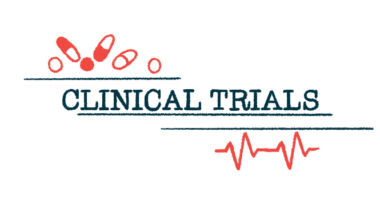Why I’m embracing the use of personal healthcare technology
Though sometimes I'm overwhelmed by data, the possibilities are encouraging

I’ve always been a tech nerd, falling in love with the newest tool in the Internet of Things, such as my Fitbit and phone, which can display various body statistics and control my transcutaneous electrical nerve stimulation (TENS) unit. Technology has become even more important since I was diagnosed with neuromyelitis optica spectrum disorder (NMOSD), because having access to my physical information gives me back some control.
But when is it too much data?
For Christmas, my husband gave me an ultraviolet light face mask. I seem a little like a horror-film character while wearing it, but I’m not looking at myself, so that’s not a concern. The face mask cycles through three phases: a red light that reduces wrinkles, a red light with infrared that improves radiance, and a blue light that kills bacteria. These all come with an optional face massage feature.
I now say it’s my favorite nine minutes of the day because it doesn’t record any data. It forces me to take time to relax, destress, and let my mind wander, which is crucial for everyone, but especially for patients. When I have my occasional eye pain, I’ll sometimes cycle through the nine-minute program more than a couple of times.
Then there’s the technology that does collect my data. For instance, I recently registered with a database that stores all of my MRIs, CT scans, and X-rays. (I’m known for being somewhat aggressive with my body, which has led to a few broken bones.) The database sends me text messages reminding me to view my recent scans and send them to my clinicians. I’m also registered with my local laboratory, which sends me reminders to view my regular bloodwork.
While I’m never surprised by any results, it doesn’t feel great to get the reminder that these tests exist and are now just part of my lifestyle. I’ve always maintained that my health is part of me and not my entire existence. While it may seem as if I’d prefer to ignore the obvious, I believe this approach is how I’ve pushed forward in the 14 years I’ve had NMOSD.
The future of technology in healthcare
Other uses of technology, however, give me hope.
One technology that I wish I saw more of in Canada, where I live, is the use of blockchain in healthcare. My favorite example of blockchain technology is when I order a pizza online and then see the update that 1) the store has received my order, 2) someone is making it, and 3) it’s finally en route to being delivered. Blockchain hasn’t been implemented for use with my medical tests, so while the databases remind me to forward the results and notify my clinicians, I can’t see when the results I’ve sent on are finally reviewed.
Further, I can’t wait until we’re able to use more virtual reality therapies or other tools that are less invasive. Even though I receive needles regularly, I still get nervous beforehand. That hasn’t helped my phobia or my stress levels.
I’d also like to see technology used to track my symptoms. I now write everything down because my memory isn’t what it used to be, partly because of age but also because of NMOSD. When my clinicians ask me when my symptoms started, I struggle to recall and have to resort to my journal notes. Eventually, we’ll have an app that tracks our symptoms and can provide the median frequency and average number of days they occur.
As we look ahead, the possibilities for leveraging technology to enhance healthcare outcomes and promote wellness are virtually limitless. From preventive health measures and early disease detection to personalized treatment regimens and remote patient monitoring, the synergy between technology and health holds tremendous promise for improving the quality of life for patients.
While embracing these innovations and fostering collaboration among technology developers, healthcare providers, and policymakers might seem scary, ultimately they’ll be key to realizing the full potential of technology-enabled healthcare solutions in the years to come.
Note: Neuromyelitis News is strictly a news and information website about the disease. It does not provide medical advice, diagnosis, or treatment. This content is not intended to be a substitute for professional medical advice, diagnosis, or treatment. Always seek the advice of your physician or other qualified health providers with any questions you may have regarding a medical condition. Never disregard professional medical advice or delay in seeking it because of something you have read on this website. The opinions expressed in this column are not those of Neuromyelitis News or its parent company, Bionews, and are intended to spark discussion about issues pertaining to neuromyelitis optica spectrum disorder.








Comments